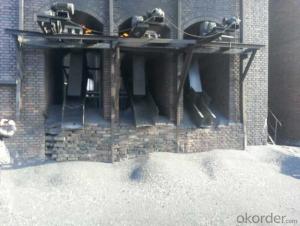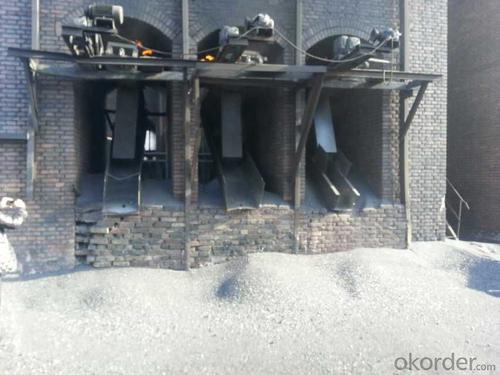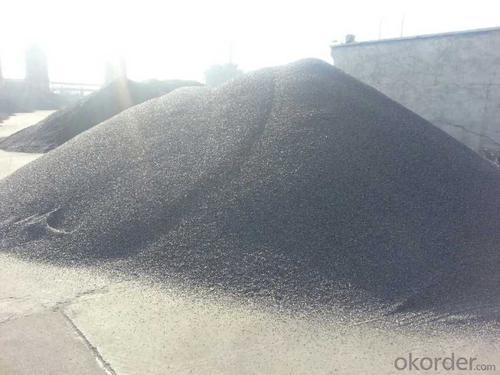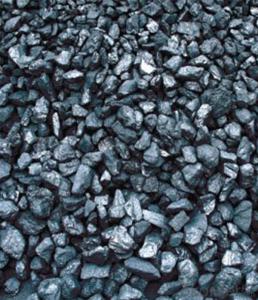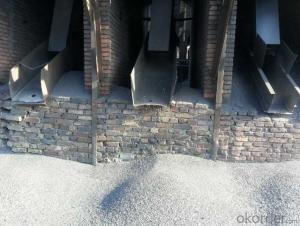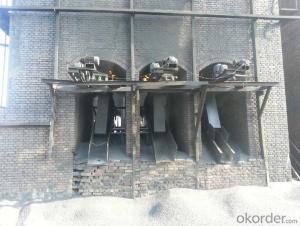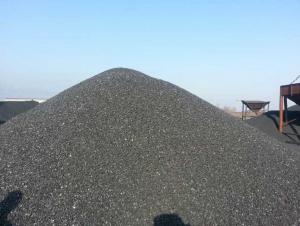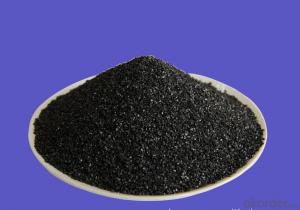Calcined Anthracite FC90-95 with stable quality
- Loading Port:
- Tianjin
- Payment Terms:
- TT OR LC
- Min Order Qty:
- 20 m.t.
- Supply Capability:
- 3000 m.t./month
OKorder Service Pledge
OKorder Financial Service
You Might Also Like
Packaging & Delivery
25kgs/50kgs/1ton per bag or as buyer's request
Specifications
Calcined Anthracite
Fixed carbon: 90%-95%
S: 0.5% max
Size: 0-3. 3-5.3-15 or as request
It used the high quality anthracite as raw materials through high temperature calcined at over 2000 by the DC electric calciner with results in eliminating the moisture and volatile matter from anthracite efficiently, improving the density and the electric conductivity and strengthening the mechanical strength and anti-oxidation. It has good characteristics with low ash, low resistvity, low sulphur, high carbon and high density. It is the best material for high quality carbon products.
Advantage and competitive of caclined anthracite:
1. strong supply capability
2. fast transportation
3. lower and reasonable price for your reference
4.low sulphur, low ash
5.fixed carbon:95% -90%
6..sulphur:lower than 0.3%
General Specification of Calcined Anthracite:
| FC | 95 | 94 | 93 | 92 | 90 |
| ASH | 4 | 5 | 6 | 6.5 | 8.5 |
| V.M. | 1 | 1 | 1 | 1.5 | 1.5 |
| S | 0.3 | 0.3 | 0.3 | 0.35 | 0.35 |
| MOISTURE | 0.5 | 0.5 | 0.5 | 0.5 | 0.5 |
Pictures
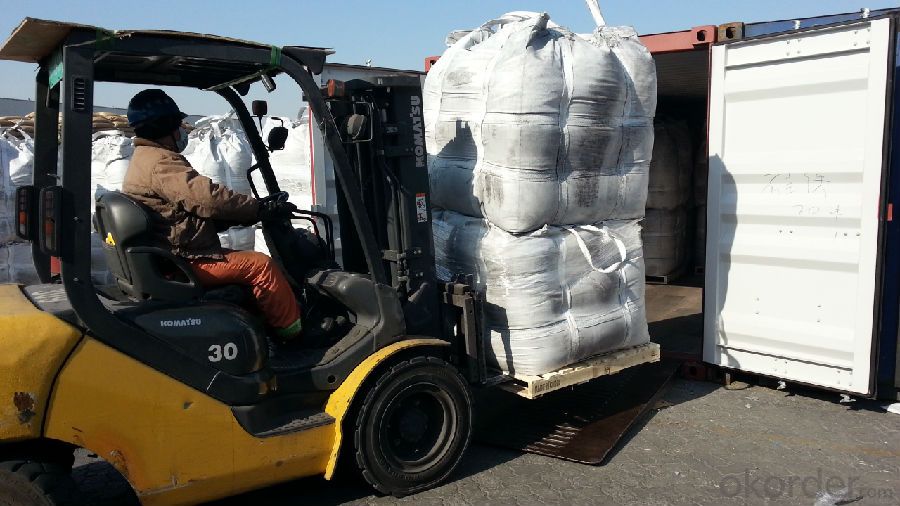
We are also strong at below materials, please contact us if you are interested in any of them:
Calcined Petroleum Coke
Carbon Electrode Paste
Carbon Electrode
- Q: How are carbon nanomaterials used in electronics?
- Carbon nanomaterials are widely used in electronics due to their unique properties and versatility. One of the most common applications of carbon nanomaterials in electronics is in the development of highly efficient and flexible conductive materials. Carbon nanotubes (CNTs) and graphene, both carbon nanomaterials, possess excellent electrical conductivity, making them ideal for creating conductive components in electronic devices. CNTs are cylindrical structures made of rolled-up graphene sheets. They can be used as interconnects in integrated circuits, improving their performance by reducing resistance and enhancing heat dissipation. Additionally, CNTs can be used in transistors, enabling faster and more efficient switching due to their high electron mobility. Their small size and flexibility make them suitable for creating transparent conductive films used in touchscreens and flexible electronics. Graphene, on the other hand, is a two-dimensional sheet of carbon atoms arranged in a hexagonal lattice. It is renowned for its exceptional electrical conductivity, high electron mobility, and excellent thermal conductivity. Graphene-based materials can be used as electrodes in batteries and supercapacitors, enhancing their energy storage capacity. Graphene transistors have the potential to replace traditional silicon-based transistors, allowing for faster and more energy-efficient electronic devices. Moreover, carbon nanomaterials, particularly CNTs, have shown promise in the field of nanoelectromechanical systems (NEMS). NEMS devices are incredibly small and sensitive, enabling applications such as sensors, actuators, and resonators. CNT-based NEMS devices have demonstrated exceptional sensitivity and responsiveness, making them suitable for various sensing applications, including pressure, gas, and biological sensing. In summary, carbon nanomaterials play a crucial role in electronics by providing highly conductive and versatile materials for various components and applications. Their unique properties, such as excellent electrical and thermal conductivity, make them ideal for creating faster, more efficient, and flexible electronic devices. As research and development in this field continue to progress, carbon nanomaterials are expected to revolutionize the electronics industry.
- Q: What are the consequences of increased carbon emissions on coral reefs?
- The consequences of increased carbon emissions on coral reefs are highly detrimental. Elevated carbon dioxide levels in the atmosphere lead to ocean acidification, which negatively impacts the ability of corals to build their calcium carbonate skeletons. This results in weakened and brittle coral structures, making them more susceptible to damage from storms and other environmental stressors. Additionally, higher temperatures caused by carbon emissions contribute to coral bleaching events, where corals expel the symbiotic algae that provide them with essential nutrients and vibrant colors. These combined effects of ocean acidification and warming ultimately lead to significant coral reef degradation, loss of biodiversity, and the decline of ecosystem services provided by these valuable marine habitats.
- Q: What are the industrial uses of diamonds?
- Diamonds have a wide range of industrial uses due to their exceptional physical properties. One of the most common industrial uses of diamonds is in the manufacturing of cutting and grinding tools. Diamond-tipped saw blades, drill bits, and grinding wheels are highly sought after for their superior hardness and abrasion resistance. These tools are used to cut and shape hard materials like concrete, ceramics, and metals. Diamonds also find extensive applications in the electronics industry. They are used as heat sinks in high-power electronic devices and as abrasive materials for polishing and lapping electronic components. The thermal conductivity of diamonds allows them to efficiently dissipate heat, making them ideal for electronic devices that generate a lot of heat during operation. Furthermore, diamonds are used in the production of specialized windows, lenses, and prisms for various scientific and industrial applications. Their optical properties, such as high refractive index and low dispersion, make them valuable for creating precision optics used in lasers, spectroscopy, and telecommunications. In addition, diamonds have found niche uses in the medical and dental fields. They are used in surgical tools such as scalpels and dental drills due to their exceptional hardness and ability to retain sharp edges. Diamond coatings are also applied to medical implants and prosthetics to improve their wear resistance and biocompatibility. Lastly, diamonds are utilized in the oil and gas industry for drilling and exploration purposes. Diamond drill bits are capable of penetrating extremely hard rock formations, making them essential for extracting oil and natural gas from deep beneath the Earth's surface. Overall, the industrial uses of diamonds are vast and diverse, ranging from cutting and grinding tools to electronics, optics, medicine, and even oil and gas exploration. The unique properties of diamonds make them indispensable in numerous industrial applications, contributing to advancements in various fields.
- Q: How does carbon impact the availability of sustainable agriculture practices?
- The availability of sustainable agriculture practices is affected by carbon in several ways. Firstly, climate change is contributed to by carbon emissions from human activities, such as burning fossil fuels and deforestation. This change in climate patterns can result in extreme weather events like droughts, floods, and heatwaves, which can have a negative impact on agricultural productivity. Furthermore, the excessive presence of carbon in the atmosphere adds to the greenhouse effect, trapping heat and increasing global temperatures. This rise in temperature can disrupt natural ecosystems and decrease the amount of arable land available for agriculture. It can also change precipitation patterns, causing water scarcity or excessive rainfall, both of which can hinder sustainable agriculture practices. Carbon also plays a role in the health and fertility of soil. Soils can absorb excessive carbon dioxide from the atmosphere, which leads to increased soil acidity. This acidification can lower soil pH levels, making it difficult for crops to absorb necessary nutrients. Additionally, high carbon levels can affect soil microorganisms, which are essential for nutrient cycling and maintaining soil fertility. However, carbon can also have positive effects on sustainable agriculture practices. Carbon sequestration, the process of capturing and storing carbon dioxide from the atmosphere, can be utilized to improve soil health. Practices such as planting cover crops, adopting agroforestry systems, and implementing no-till farming techniques can help sequester carbon in the soil, enhancing its fertility and ability to withstand challenges. This, in turn, promotes sustainable agriculture by increasing crop yields, reducing the need for synthetic fertilizers, and improving the soil's ability to retain water. In conclusion, carbon emissions and their impact on climate change and soil health have a significant influence on the availability of sustainable agriculture practices. It is crucial to mitigate carbon emissions and adopt practices that sequester carbon in order to ensure a sustainable and resilient agricultural system in the face of climate change.
- Q: What should be done to deal with leakage of carbon monoxide from the plant?
- The container should be cooled by heat in time. The harm to health, carbon monoxide and hemoglobin binding capacity than oxygen 200 times larger, after inhalation, in the blood and hemoglobin binding, interference blood carrying oxygen capacity, resulting in tissue hypoxia. The skin starts to become gray, and the skin and mucous membranes are red. Severe damage to brain cells can also cause secondary diseases, light damage to the heart, and damage to pyramidal or extrapyramidal systems, including the basal ganglia. Acute poisoning: mild poisoning are headache, dizziness, lethargy, tinnitus, palpitation, nausea, vomiting, weakness, abdominal pain, weakness and other symptoms; moderate poisoning in addition to the above symptoms, and complexion, lips cherry red, rapid pulse, irritability, instability of gait, fuzzy consciousness, coma patients remain unconscious;, miosis, muscle tension increased, frequent convulsions, incontinence, depth of poisoning due to respiratory paralysis and death. Chronic effects: the main manifestation of long-term inhalation of a certain amount of carbon monoxide, fatigue, irritability, indigestion and so on, can cause damage to the nervous and cardiovascular system. The compressed gas storage requirements in bottles, should be stored in a cool, ventilated warehouse, storage temperature should not exceed 300C; keep away from heat, avoid direct sunlight; and oxygen, compressed air, oxidant and stored separately; avoid mixed mixed transport. The lighting, ventilation and other facilities in the storage room shall be explosion-proof, and the switch is located outside the warehouse. Equipped with appropriate varieties and corresponding quantity of fire-fighting equipment.
- Q: How does carbon dioxide affect textile production?
- Textile production can be significantly impacted by carbon dioxide in various ways. Firstly, the manufacturing process of textiles generates carbon dioxide, which contributes to overall greenhouse gas emissions and worsens climate change. This, in turn, can result in long-term consequences like extreme weather events, rising temperatures, and sea-level rise. These outcomes can disrupt the supply chain and production of textiles. Furthermore, carbon dioxide emissions from textile production contribute to air pollution, which can adversely affect human health. Workers exposed to high levels of carbon dioxide may experience respiratory problems and other respiratory diseases as a result of the release of this greenhouse gas. Moreover, carbon dioxide is commonly used in the dyeing and finishing process of textile production. However, this practice can have detrimental effects on the environment. When carbon dioxide is released into water bodies during the dyeing process, it can contribute to water pollution, contaminating water sources and harming aquatic life. Additionally, excessive use of carbon dioxide in textile production can have economic implications. Since carbon dioxide is a byproduct of burning fossil fuels, its production is inherently tied to the consumption of non-renewable resources. The reliance on fossil fuels makes textile production vulnerable to price fluctuations, as the cost of carbon dioxide emissions and energy production can vary significantly. To mitigate the negative impacts of carbon dioxide on textile production, several measures can be implemented. These include adopting cleaner production techniques and technologies that reduce carbon dioxide emissions, such as utilizing renewable energy sources or implementing carbon capture and storage systems. Furthermore, investing in sustainable and environmentally-friendly materials, like organic cotton or recycled fibers, can help reduce the carbon footprint of textile production. Overall, reducing carbon dioxide emissions in textile production is crucial for the industry to become more sustainable and mitigate its environmental and health impacts.
- Q: How does carbon impact ocean acidity?
- Carbon impacts ocean acidity through a process called ocean acidification. When carbon dioxide (CO2) from human activities is emitted into the atmosphere, a significant portion of it is absorbed by the ocean. Once in the ocean, CO2 reacts with water to form carbonic acid, which lowers the pH of seawater, making it more acidic. This increased acidity can have detrimental effects on marine life, particularly on shell-forming organisms like corals, mollusks, and some plankton, as it hampers their ability to build and maintain their calcium carbonate structures. Additionally, ocean acidification disrupts the delicate balance of marine ecosystems, affecting various species and ultimately impacting the entire food chain.
- Q: How does carbon affect the pH of water?
- Carbon can affect the pH of water through the process of carbonation. When carbon dioxide (CO2) dissolves in water, it reacts with the water molecules to form carbonic acid (H2CO3). This reaction increases the concentration of hydrogen ions (H+) in the water, resulting in a decrease in pH. Therefore, carbonation lowers the pH of water, making it more acidic. Additionally, carbonic acid can further dissociate into bicarbonate ions (HCO3-) and hydrogen ions (H+), which also contribute to the increase in acidity. It is important to note that the impact of carbonation on pH depends on the concentration of carbon dioxide present in the water.
- Q: Which carbon content is larger, steel or pig iron?
- carbon content more than 2.11% of iron, iron carbon content in general industry 2.5%--4%. I hope I can help you.
- Q: How does carbon dioxide affect the formation of clouds?
- Cloud formation is significantly influenced by carbon dioxide in Earth's climate system. This is because carbon dioxide acts as a greenhouse gas, trapping heat in the atmosphere and causing a global increase in temperatures. This rise in temperature affects various atmospheric processes, including the formation of clouds. One of the main ways carbon dioxide impacts cloud formation is by affecting the water cycle. Increased levels of carbon dioxide lead to warmer temperatures, which result in more water evaporating from the Earth's surface. This increased evaporation leads to a higher amount of water vapor in the atmosphere, which is essential for the formation of clouds. In addition, carbon dioxide indirectly influences cloud formation by influencing atmospheric stability and the vertical movement of air. Higher concentrations of carbon dioxide can change the temperature profile of the atmosphere, causing the lower atmosphere to warm more than the upper atmosphere. This temperature difference can alter air density, causing air to rise or sink. Rising air promotes cloud formation, while sinking air inhibits it. Moreover, carbon dioxide affects the size and properties of cloud droplets. Increased concentrations of carbon dioxide can result in changes in the microphysical properties of clouds, such as smaller droplet size and concentration. Research suggests that higher carbon dioxide levels may impact cloud lifetime and precipitation patterns. It is important to note that the relationship between carbon dioxide and cloud formation is complex and remains an active area of research. Scientists are continuously studying the intricate interactions between atmospheric gases, cloud formation, and climate change to gain a better understanding of the future implications of carbon dioxide emissions on cloud dynamics and the overall climate system.
Send your message to us
Calcined Anthracite FC90-95 with stable quality
- Loading Port:
- Tianjin
- Payment Terms:
- TT OR LC
- Min Order Qty:
- 20 m.t.
- Supply Capability:
- 3000 m.t./month
OKorder Service Pledge
OKorder Financial Service
Similar products
Hot products
Hot Searches
Related keywords
